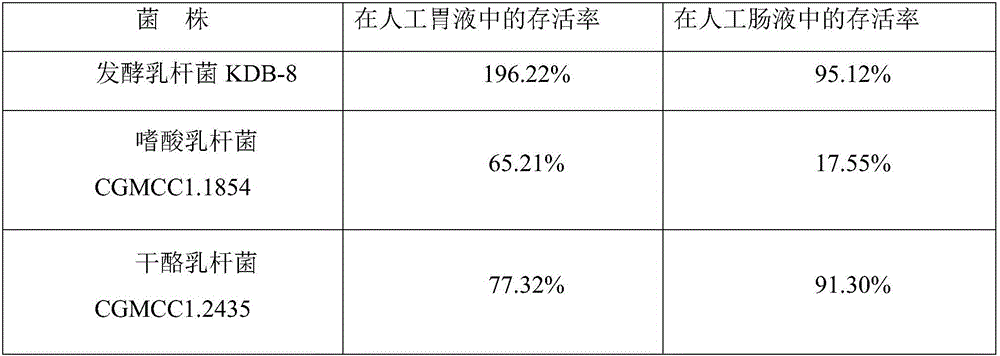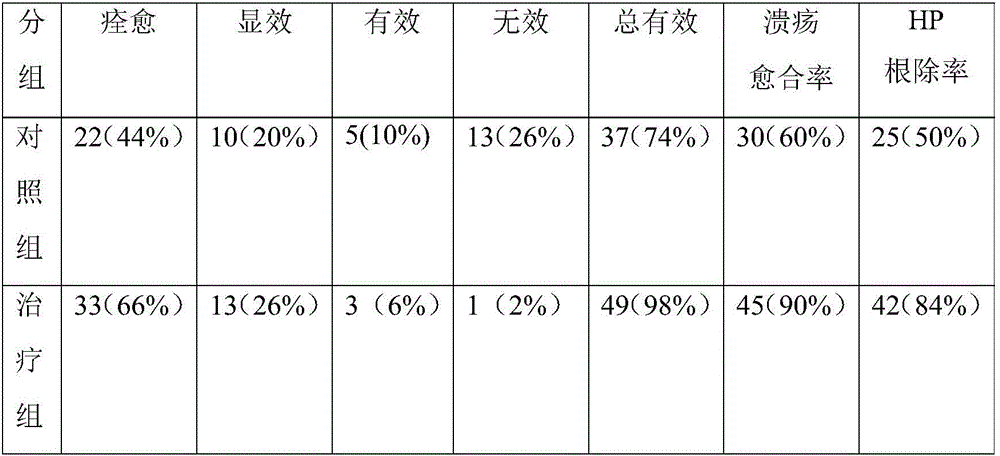Lactic acid bacterium preparation and application thereof in treatment of gastric ulcer
A technology for lactic acid bacteria and gastric ulcer, applied in the direction of bacteria, microbe-based methods, and resistance to vector-borne diseases, etc., to achieve effective proliferation, improve curative effect, and strong tolerance
- Summary
- Abstract
- Description
- Claims
- Application Information
AI Technical Summary
Problems solved by technology
Method used
Image
Examples
Embodiment 1
[0024] Embodiment 1 Lactobacillus fermentum KDB-8 isolation screening and identification:
[0025] 1. Screening samples
[0026] Naturally fermented sauerkraut juice was collected from the countryside of Sujiatun, Shenyang as an isolated sample. The sauerkraut juice has no pollution in appearance, pure taste, and has been fermented for more than one year. It is filtered and used for later use.
[0027] 2. Preliminary screening of lactic acid bacteria
[0028] Take 5 mL of filtered sauerkraut juice and add 45 mL of sterile water, mix well, spread on the MRS plate with 0.5% calcium carbonate, incubate at 37°C for 48 hours, isolate and culture the strains with transparent circles, and obtain 42 strains of lactic acid bacteria.
[0029] 3. Screening of antibacterial lactic acid bacteria
[0030] 1) Preparation of lactic acid bacteria liquid: inoculate 32 strains of lactic acid bacteria obtained from primary screening into 100mL MRS liquid medium, and culture at 37°C for 48 hours...
Embodiment 2
[0039] Example 2 Lactobacillus fermentum KDB-8 acid resistance, bile salt resistance experiment
[0040] 1. Gastric acid resistance test method:
[0041] Get 40ml of activated Lactobacillus fermentum KDB-8 bacterial suspension and add it to a 50ml centrifuge tube, centrifuge (5000g, 5min) to collect the thalline, wash twice with PBS buffer, add 40ml artificial gastric juice (take dilute hydrochloric acid) to the centrifuge tube Add 16.4ml of water and shake to dilute to 1000ml, adjust the pH to 2.0 with concentrated hydrochloric acid or 10% NaOH, sterilize at 121°C for 30min, add pepsin at a ratio of 1g / 100ml in a sterile room, incubate in a water bath at 37°C for 2h, Shake once every 30 minutes, take samples at 0h and 2h for counting viable bacteria, and use the 0h sample as a control to calculate the survival rate of the 2h sample bacteria, survival rate = (the number of viable bacteria at 2h / the number of viable bacteria at 0h) ×100%.
[0042] 2. Test method for bile salt...
Embodiment 3
[0048] Embodiment 3 Lactobacillus fermentum KDB-8 is to the removal effect of cholesterol
[0049] This experiment refers to the method of Brashears et al. (1998) with slight improvements.
[0050] The activated Lactobacillus fermentum KDB-8 strain was inoculated in the MRS medium and cultured overnight at 37°C as the seed solution.
[0051] Prepare MRS medium containing 5% (v / v) egg yolk liquid, take 2ml of medium, centrifuge at 5000r / min for 7min, take 1ml of supernatant and put it in a centrifuge tube, add 9ml of absolute ethanol, shake for 5min, 10000r Centrifuge for 10 min at 1 / min, take 2 ml of supernatant and add 2 ml of P-Fe-S reagent, mix and react in ice bath for 30 min, measure OD550, and calculate the initial content of cholesterol in the medium.
[0052] Then, inoculate the seed liquid of Lactobacillus fermentum KDB-8 into the above-mentioned MRS medium, and after culturing at 37°C for 24 hours, measure the final content of cholesterol in the medium again, and ca...
PUM
| Property | Measurement | Unit |
|---|---|---|
| Diameter | aaaaa | aaaaa |
Abstract
Description
Claims
Application Information
 Login to View More
Login to View More - R&D
- Intellectual Property
- Life Sciences
- Materials
- Tech Scout
- Unparalleled Data Quality
- Higher Quality Content
- 60% Fewer Hallucinations
Browse by: Latest US Patents, China's latest patents, Technical Efficacy Thesaurus, Application Domain, Technology Topic, Popular Technical Reports.
© 2025 PatSnap. All rights reserved.Legal|Privacy policy|Modern Slavery Act Transparency Statement|Sitemap|About US| Contact US: help@patsnap.com


